Special Collections and Archives > University Archives > Highlights of Cal Poly History > Timeline of Cal Poly’s History
1901
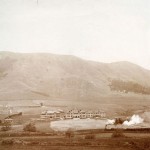 On March 8, Governor Gage signs the bill establishing the California Polytechnic School. The school furnishes “to young people of both sexes mental and manual training in the arts and sciences, including agriculture, mechanics, engineering, business methods, domestic economy and other branches as will fit the students for non-professional walks of life.” Myron Angel, a local journalist, is the driving force behind the founding of the school.
On March 8, Governor Gage signs the bill establishing the California Polytechnic School. The school furnishes “to young people of both sexes mental and manual training in the arts and sciences, including agriculture, mechanics, engineering, business methods, domestic economy and other branches as will fit the students for non-professional walks of life.” Myron Angel, a local journalist, is the driving force behind the founding of the school.- 1902
- Leroy Anderson is appointed as the first director of the school in June.
- 1903
- On January 31, the cornerstone for the Administration Building is laid. Construction follows on the boys’ dormitory. Land is designated for student farms and construction begins on farm buildings.
- 1903
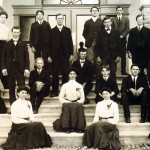 On October 1, the first classes are held. Total enrollment for the first year is 20 students. The California Polytechnic School offers a secondary level Course of Study, which takes three years to complete.
On October 1, the first classes are held. Total enrollment for the first year is 20 students. The California Polytechnic School offers a secondary level Course of Study, which takes three years to complete.- 1903
- In October, a committee of students and faculty draft a constitution and by-laws for the “California Polytechnic School Athletic Association.”
- 1904
- In May, the first annual Farmers’ Institute and Basket Picnic is held. Members of the community are invited to the campus to see projects completed by students.
- 1904-05
 Enrollment rises to 60 students (46 men and 14 women).
Enrollment rises to 60 students (46 men and 14 women).- 1906
- On June 15, the first commencement is held as eight students receive diplomas.
- 1908
- Leroy Burns Smith is appointed director, after serving as vice director the previous year.
- 1909
 The first student body association is formed to govern athletics, debating, publications, and social events.
The first student body association is formed to govern athletics, debating, publications, and social events.- 1912-13
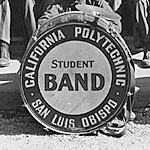 The time necessary to complete the Course of Study is lengthened from three years to four years.
The time necessary to complete the Course of Study is lengthened from three years to four years.- 1913
- The annual Farmers’ Picnic is combined with the Decennial Celebration, with special trains scheduled to bring 3,000 visitors to the campus.
- 1914
 In June, Robert Weir Ryder is appointed director.
In June, Robert Weir Ryder is appointed director.- 1916
- An Academic Department for college preparatory work is added to the three original departments of Agriculture, Mechanics and Household Arts.
- 1915-16
- Compulsory military training for men is instituted in response to state legislation. Military discipline and uniforms are required in the dormitories as well as the classrooms.
- 1916
- The Polygram, the school newspaper, begins publication. The paper is issued every two weeks.
- 1917-19
- Enrollment drops as students enlist to fight in World War I, while remaining students participate in war relief projects.
- 1917-21
- The California Polytechnic School provides vocational education to hundreds of disabled war veterans of all races and nationalities.
- 1921
- Courses in bookkeeping, typing, and advertising are offered in the newly established Commercial Department.
- 1921
- Nicholas Ricciardi is selected president by the Board of Trustees.
- 1921
- The local Board of Trustees is disbanded and control is transferred to the State Board of Education.
- 1923
- A four-year course of study in printing begins.
- 1923
- Drastic budget cuts force a reduction in the number of classes offered. Only classes in agriculture, mechanics and printing remain. Nine female students enroll in printing classes after their former Courses of Study are eliminated.
- 1924
- Margaret Chase, vice president of the school, is appointed acting president for the remainder of the academic year after the resignation of Nicholas Ricciardi.
- 1924
- A committee of 15 local citizens is formed to study the school’s objectives and direction.
- 1924
- The San Luis Obispo Local Committee of Fifteen and the State Board of Education choose Benjamin R. Crandall as president.
- 1925
- Enterprise projects — the forerunner to today’s senior projects — are established for agriculture students, who spend mornings in class and afternoons on their projects. “Earn while you learn” is the motto for the program. A Junior Farm Center Loan Fund, forerunner of today’s Corporation, is established to provide students with financial aid for projects.
- 1926
- Classes in the Academic, Household Arts, and Commercial Departments are restored.
- 1927
 The school adds a two-year Junior College Division to the four-year secondary vocational program. Engineering/Mechanics is the principal course of study and Aeronautics is also added to the Junior College Division.
The school adds a two-year Junior College Division to the four-year secondary vocational program. Engineering/Mechanics is the principal course of study and Aeronautics is also added to the Junior College Division.- 1927
- The name Cal Poly comes into popular use.
- 1929
- Women students are barred from attending Cal Poly by legislative act beginning in 1930.
1931
- The Agriculture Department is transferred to the direct supervision of the State Bureau of Agricultural Education. Under direction of Bureau Chief Julian McPhee, the Polytechnic School becomes the state headquarters of Future Farmers of America and the centralized institution for training of vocational agricultural teachers.
- 1932-33
- The State Board of Education drastically reorganizes the school, abolishing the Junior College Division and the high school courses designed for university transfer. The mission of the school is changed to a two-year technical and vocational school.
- 1933
- The first annual Poly Royal is sponsored by the Future Farmers of America.
- 1933
- Julian A. McPhee is appointed president.
- 1935
- The school begins to receive funds from pari-mutuel betting at horse races held at county fairs throughout the state.
- 1935
 Amelia Earhart visits the campus.
Amelia Earhart visits the campus.- 1937
- The legislation barring women students is repealed, but women are not admitted as students until 1956.
- 1938
- Cal Poly receives its first million-dollar gift when Charles and Jerry Voorhis donate their Southern California ranch for use as a horticultural training center.
- 1938
- On November 4, after a six-year hiatus, the school paper is published again. Formerly The Polygram, it is now entitled El Mustang.
1940
- The State Board of Education grants collegiate status to the California Polytechnic School. The name of the institution is not changed until 1947.
- 1940-43
- Cal Poly implements war-preparedness training programs in industrial arts for men and women.
- 1942
 The first bachelor’s degrees are awarded.
The first bachelor’s degrees are awarded.- 1943
- The school serves as state headquarters for the Food Production War Training Program, providing instruction to 120,000 California farmers.
- 1943-44
 A U.S. Naval Flight Preparatory School on the Cal Poly campus trains over 3,600 cadets; civilian enrollment falls to 80 students.
A U.S. Naval Flight Preparatory School on the Cal Poly campus trains over 3,600 cadets; civilian enrollment falls to 80 students.- 1945
- Enrollment expands to 819 students, primarily veterans studying under the G.I. Bill.
- 1947
- The California Polytechnic School is renamed the California State Polytechnic College and begins offering graduate programs in education.
- 1949
- The W.K. Kellogg Foundation donates an 812-acre horse ranch in Pomona to the college, which is located near the Voorhis campus. By 1950, the joint operation of the two campuses is known as the Kellogg-Voorhis Unit.
- 1949
- The San Luis Obispo and Pomona campuses combine resources to produce the first Cal Poly float for the Tournament of Roses Parade in Pasadena, California.
- 1949
- Enrollment rises to 2,909 students at the San Luis Obispo campus. A graduate program leading to a master’s degree in education begins.
1952
 Cal Poly begins participation in the International Cooperation Administration (ICA), a federal program which brought “numerous foreign students” from Asia, South America, the Caribbean, and Africa to receive teacher education in agriculture, communications, architecture and engineering.
Cal Poly begins participation in the International Cooperation Administration (ICA), a federal program which brought “numerous foreign students” from Asia, South America, the Caribbean, and Africa to receive teacher education in agriculture, communications, architecture and engineering.- 1956
- Female students are again admitted to the college.
- 1956
 The home economics program is reintroduced, successfully spinning off programs in dietetics and nutrition, family studies, child development, and textiles research.
The home economics program is reintroduced, successfully spinning off programs in dietetics and nutrition, family studies, child development, and textiles research.
- 1960
- On October 29, sixteen football players, the team’s student manager, and a Cal Poly football booster lose their lives in the crash of the Cal Poly Mustangs’ plane in Toledo, Ohio. Twenty-two others are injured, some gravely.
- 1960
 Control of Cal Poly and all other state colleges is transferred from the State Board of Education to an independent Board of Trustees.
Control of Cal Poly and all other state colleges is transferred from the State Board of Education to an independent Board of Trustees.- 1963
- The Computer Center is established.
- 1966
- On June 30, Julian McPhee retires after serving 33 years as president.
- 1966
- The Kellogg-Voorhis Unit is split from Cal Poly and becomes a separate college. Enrollment in San Luis Obispo reaches 7,740 students (2,087 women and 5,653 men).
- 1967
- On May 1, Robert E. Kennedy is named president by the CSU Board of Trustees.
- 1967
- The curriculum is reorganized into four units: School of Agriculture, School of Engineering, School of Applied Arts, and School of Applied Sciences.
- 1967
- On April 10, the campus newspaper’s name is changed to the Mustang Daily, although the paper is only published three times a week.
- 1968
- The School of Architecture is created. Fall quarter enrollment rises to 9,711 students (2,796 women and 6,915 men).
- 1970
- The curriculum is reorganized into seven units: School of Agriculture and Natural Resources, School of Architecture and Environmental Design, School of Business and Social Sciences, School of Communicative Arts and Humanities, School of Engineering and Technology, School of Human Development and Education, and School of Science and Mathematics.
- 1971
 The Julian A. McPhee Union is dedicated on March 6.
The Julian A. McPhee Union is dedicated on March 6.- 1972
- Cal Poly’s official name is changed to California Polytechnic State University by the state legislature.
- 1977
- The new Architecture Building opens for classes on January 13. Enrollment reaches 15,502 students (5,952 women and 9,550 men).
- 1978
 The Clyde P. Fisher Science Building is dedicated on July 28.
The Clyde P. Fisher Science Building is dedicated on July 28.- 1979
- On February 1, Robert E. Kennedy retires.
- 1979
 Warren J. Baker is named president by the CSU Board of Trustees on May 22.
Warren J. Baker is named president by the CSU Board of Trustees on May 22.
1981
 The Robert E. Kennedy Library opens on January 5.
The Robert E. Kennedy Library opens on January 5.- 1986
- The curriculum is reorganized into seven new units: School of Agriculture, School of Architecture and Environmental Design, School of Business, School of Liberal Arts, School of Engineering, School of Professional Studies and Education, School of Science and Mathematics.
- 1986
 15,450 students are enrolled spring quarter (6,700 women and 8,750 men).
15,450 students are enrolled spring quarter (6,700 women and 8,750 men).- 1988
- The Agricultural Science building is completed.
- 1989
- The Foundation Administration building is completed.
1990
- The last El Rodeo yearbook is issued.
- 1990
- The University Center for Teacher Education is created.
- 1991
- Construction is finished on the new Faculty Offices East Building.
- 1992
- The Dairy Science I facility is completed.
- 1992
- Academic units within the university are reorganized into colleges:College of Agriculture, College of Architecture and Environmental Design, College of Business, College of Engineering, College of Liberal Arts, and College of Science and Mathematics.
- 1992
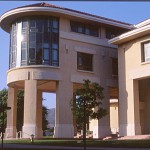 The Business Building and a remodel of the Education Building are completed.
The Business Building and a remodel of the Education Building are completed.- 1993
- The Children’s Center is completed.
- 1993
- Alumnus Al Smith bequeaths his 3,200-acre ranch outside Santa Cruz, along with a substantial endowment, to the College of Agriculture.
- 1993
- A new Recreational Sports Complex opens in the spring.
- 1993
- Cal Poly earns national recognition in the “America’s Best Colleges” issue of U.S. News & World Report.
- 1994
- The Cal Poly Intercollegiate Athletic Program moves from NCAA Division II to Division I.
- 1994
- The Dairy Products Technology Center is completed.
- 1995
- The Poultry Science Instructional Center is completed.
- 1995
 Robert Gibson, Cal Poly aeronautical engineering graduate, carries the Cal Poly banner into space, commanding the Space Shuttle Atlantis to the first U.S. mid-space rendezvous with the Russian Space Station Mir.
Robert Gibson, Cal Poly aeronautical engineering graduate, carries the Cal Poly banner into space, commanding the Space Shuttle Atlantis to the first U.S. mid-space rendezvous with the Russian Space Station Mir.- 1996
- Construction of The Performing Arts Center’s Christopher Cohan Center is completed.
- 1997
The President’s Diversity Award is established. The award celebrates members of the Cal Poly community who have exhibited a commitment to diversity.
The Black Faculty and Staff Association forms from the restructuring of an organization formerly known as the Concerned Black Community (CBC). The CBC was officially recognized as a campus organization by President Baker in 1979 and served as a voice in issues regarding the recruitment, retention, and promotion of Black faculty, staff, and students.
1998
The Academic Senate adopts, and President Warren J. Baker approves, resolutions on “The Academic Value of Diversity” and the “Cal Poly Statement on Diversity.” They recommend the administration “actively reaffirm the academic value of diversity among its faculty, staff, students and within the curriculum,” and that plans and strategies be devised “to promulgate and implement the diversity and educational objectives” outlined in the documents.
1999The College of Engineering’s Advanced Technology Laboratories Building is opened. It is the first academic facility on campus to be built without state funds.
The University Diversity Enhancement Council is established. The UDEC is charged with addressing climate issues, increasing cultural competence, and making recommendations to the President’s Office on the implementation of educational programs related to diversity, inclusion and campus climate.
- 2000
- Fall quarter enrollment totals 16,877 students (9,285 men and 7,592 women).
- 2000
- A new 47-acre Sports Complex and a multi-level parking structure are completed.
- 2000
- The Paul J. Orfalea family donates $15 million to the College of Business. In recognition of this gift, the college is named the Orfalea College of Business.
- 2001
- History Day is celebrated on March 8. Cal Poly is 100 years old.
- 2001
- “Open House Presents Poly Royal” becomes the name for the annual showcase of academic achievements.
- 2001
- Unocal Corp. donates its historic pier in Avila Beach to Cal Poly for the establishment of a marine science education and research center. The Poly Pier at Port San Luis hosts a variety of ocean technology, marine biology and aqua culture classes.
- 2002
- Cal Poly is rated the best public, largely undergraduate university in the West by U.S. News & World Report for the 10th consecutive year. In addition, the university’s College of Engineering is ranked No. 9 among all engineering programs at non-doctoral schools. Aside from the three major service academies (West Point, Annapolis and the Air Force Academy), Cal Poly is the highest-rated public institution in the engineering category.
- 2002
- Cal Poly is among the 100 colleges and universities nationwide that awards the most bachelor’s degrees to Hispanic students, According to a report by the National Center for Education Statistics. It is second or third in agriculture, architecture and engineering.
- 2003
- Legendary baseball player, Osborne Earl “Ozzie” Smith delivers the commencement address. The Cal Poly alumnus is honored with a statue at Baggett Stadium and an honorary degree of Doctor of Humane Letters by President Baker.
- 2004
- The Cal Poly College of Agriculture begins offering a bachelor’s degree in Wine and Viticulture. The new major blends viticulture, enology and the business aspects of the wine industry.
- 2004
- The first doctoral candidates in the university’s history enroll in the College of Education.
- 2004
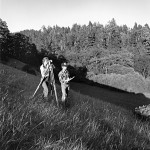 Cal Poly’s Swanton Pacific Ranch receives international sustainable forestry designation for its responsible forestry practices. The ranch was given to Cal Poly in the will of Al Smith, who died in 1993.
Cal Poly’s Swanton Pacific Ranch receives international sustainable forestry designation for its responsible forestry practices. The ranch was given to Cal Poly in the will of Al Smith, who died in 1993.- 2005
- Chicana Latino Faculty Staff Association is established (now named the Chicanx Latinx Faculty Staff Association).
- Engineering alumnus Burt Rutan is presented the President’s Medal of Excellence by President Warren J. Baker. The aviation pioneer, who graduated from Cal Poly in 1965, was awarded the Presidential Citizen’s Medal from Ronald Reagan for Voyager in 1986 and received Cal Poly’s first Honorary Doctor of Science degree in 1987.
- 2006
- The 1960 Cal Poly Mustang football team, in remembrance of the 18 who perished in the tragic plane crash, is inducted into the Cal Poly Athletics Hall of Fame. Mustang Memorial Plaza, a tribute to the team, and Mustang Memorial Field is officially dedicated at the newly renovated Alex G. Spanos Stadium.
- 2006
- John Madden is inducted into the Pro Football Hall of Fame. Recognized as a coach, the 1959 Cal Poly graduate coached the Oakland Raiders for 10 straight seasons, taking them to the Super Bowl in 1976.
- 2006-2007
- Engineering facilities, the Bonderson Projects Center and Engineering IV opens in fall 2006 and winter 2007 respectively.
- 2007
- George Ramos, Cal Poly Journalism Department chair, is inducted into the National Association of Hispanic Journalists Hall of Fame. Ramos was a three-time Pulitzer Prize-winning reporter for the Los Angeles Times.
- 2007
- The Architecture Department receives $60 million from an anonymous donor. It is the largest single gift ever made to a campus in the California State University system.
2008
University Learning Objectives, which outline what all students who complete an undergraduate or graduate program at Cal Poly should be able to do.
2010
President Warren J. Baker retires after 31 years of service.
Office of University Diversity and Inclusion, or OUDI, which works with the campus on diversity issues and efforts to foster a diverse and inclusive campus climate.
2011
Jeffrey D. Armstrong is named president of Cal Poly.
2013
Cal Poly implements the Campus Climate Project, a university-wide effort to assess the campus culture and provide recommendations to “build on the success and address initiatives to improve the overall campus climate.”
Warren J. Baker Center for Mathematics and Science opens.
2017
Cal Poly receives CSU-record $110 million gift from Alumni William L. and Linda Frost
Cal Poly eliminates the Early Decision admissions option after discovering the process disadvantaged low-income students because they would not know the full extent of their financial aid prior to making a commitment. That decision resulted in the most diverse incoming class in the university’s history.
2019
Cal Poly breaks ground on the William and Linda Frost Center for Research and Innovation